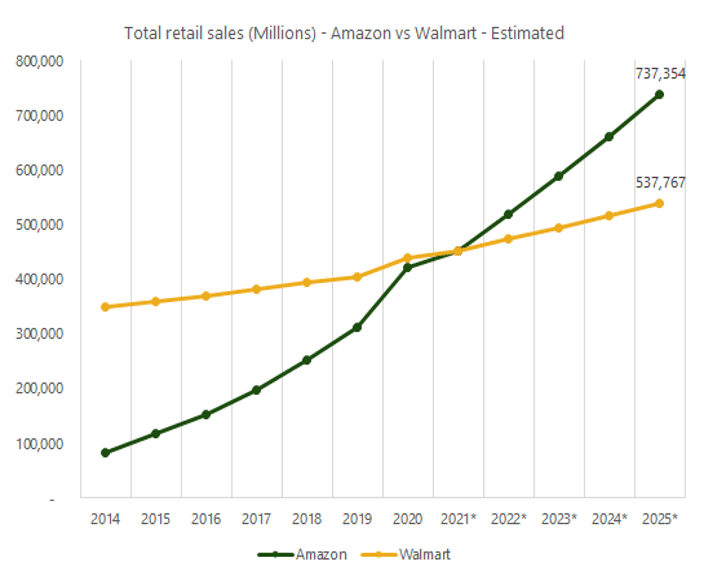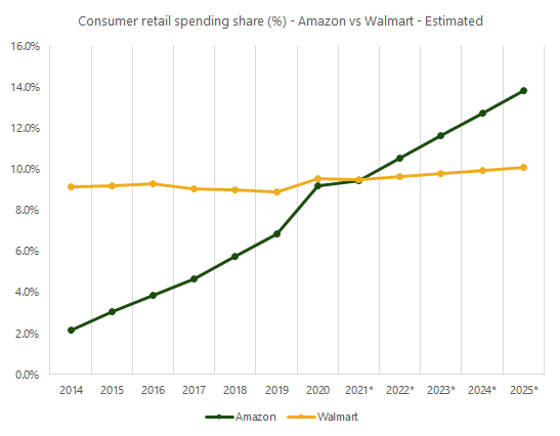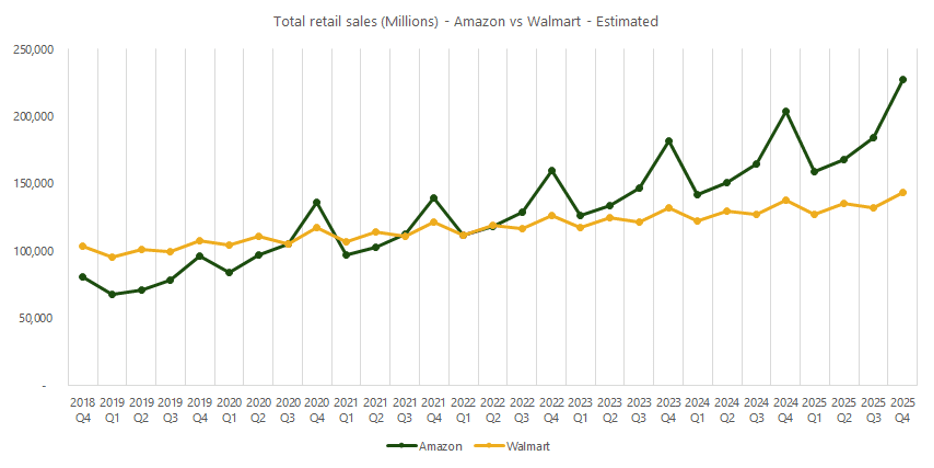Amazon Will Outgrow Walmart 3-to-1 Over Next Five Years

New research by PYMNTS shows that the long, steady revenue uptrend Amazon has posted over the past decade is set to continue and accelerate, not only breaking the current 9 percent domestic market share tie by the middle of next year, but also opening up a 40 percent lead in U.S. retail sales over the coming five years.
Put another way, PYMNTS’ analysis and projection of total US retail sales shows Amazon outgrowing Walmart by more than a three-to-one margin through 2025, by adding $315 billion in additional sales, or roughly 75 percent more than present levels.*
*PYMNTS’ methodology excludes gasoline and tabulates the gross merchandise value (GMV) of all items sold rather than just the fractional commission booked on many sales.

Source: PYMNTS data
At the same time, Walmart is pegged to add $100 billion in additional revenue over the next five years, or roughly 23 percent more than where it is now, based on PYMNTS’ data.
When viewed on an average annual percentage basis, the forward-looking forecasts break down to Walmart’s sales growing annually by about $20 billion, or 4.6 percent, versus Amazon’s $63 billion in new revenue for each of the next five year, or about 15 annual sales growth — hence the three-to-one outperformance summation.
The Big Picture
As the green line in the chart below shows, when these sales figures are translated to share of U.S. retail sales, Amazon’s stake has gone from a lagging 2 percent in 2014 to a dominant 14 percent slice in 2025.

Source: PYMNTS data
For its part, the yellow line shows that Walmart’s annual low single-digit sales growth during that same 10+-year period of time has allowed it to maintain its market share of U.S. retail sales, but it has hovered relatively consistently between 9 and 10 percent, where it is forecasted to remain.
The Quarterly Saw Blade
When looking at both the trailing and projected data on a quarterly basis, rather than annually, the trend and leadership change is more volatile. To that point, PYMNTS’ analysts have said that Amazon’s Q4 2020 and full-year 2020 results were both “out of line,” and that it is too early to be certain whether Amazon’s COVID-era surge is a change in trend, a shift or a bubble that will revert back to the mean.

Source: PYMNTS data
However, using conservative growth assumptions, the PYMNTS data projects that Amazon will surpass Walmart — once and for all — by 2022.
The PYMNTS findings and methodology imply an even swifter chain of events than analysis published by Bloomberg last week that showed the lead change not happening until 2025 — a full three years after PYMNTS estimates that the crossover will occur, and with a gap between the two retailers that is $100 billion narrower.
Based on different seasonal patterns due to Walmart’s high dependence on grocery sales, PYMNTS research said that Walmart will continue to see some quarters exceed Amazon until Q2 2022.
The Next Few Quarters
With Amazon’s Q1 earnings in the books — reflecting 44 percent top-line growth and $108 billion in revenue — the focus will once again shift to Walmart, which will report its first-quarter results on May 18.
While Walmart has committed to investing $14 billion of capital expenditures into itself this year, its top priority has been growing its digital sales and expanding its omnichannel selling. Despite that urgency, the fact remains that Walmart still does almost 95 percent of its revenue through its 5,300 U.S. locations and 6,100 international locations.
However, as more and more eCommerce companies — including Amazon — have begun to forecast a post-COVID slowing of growth, Walmart’s relatively low exposure to the dot-com side of the business could suddenly turn from a liability into an asset.
Even so, Walmart’s 2020 sales growth rate of 8.4 percent is pegged by PYMNTS to slip to 3.3 percent in 2021 before leveling off at roughly 4 to 4.5 percent through 2025.
For Amazon, PYMNTS pegs the projected sales growth cooldown at 6.9 percent this year (down from 35 percent in 2020), and then “normalizing” back to annual growth rates of 15, 13, 12 and 11.5 percent from 2022 to 2025.
This five-year growth forecast is not only in line with Amazon’s historical averages and traditional Wall Street revenue estimates, but also portrays the realistic underpinnings of PYMNTS’ predicted leadership change and the three-to-one growth momentum that’s driving it.